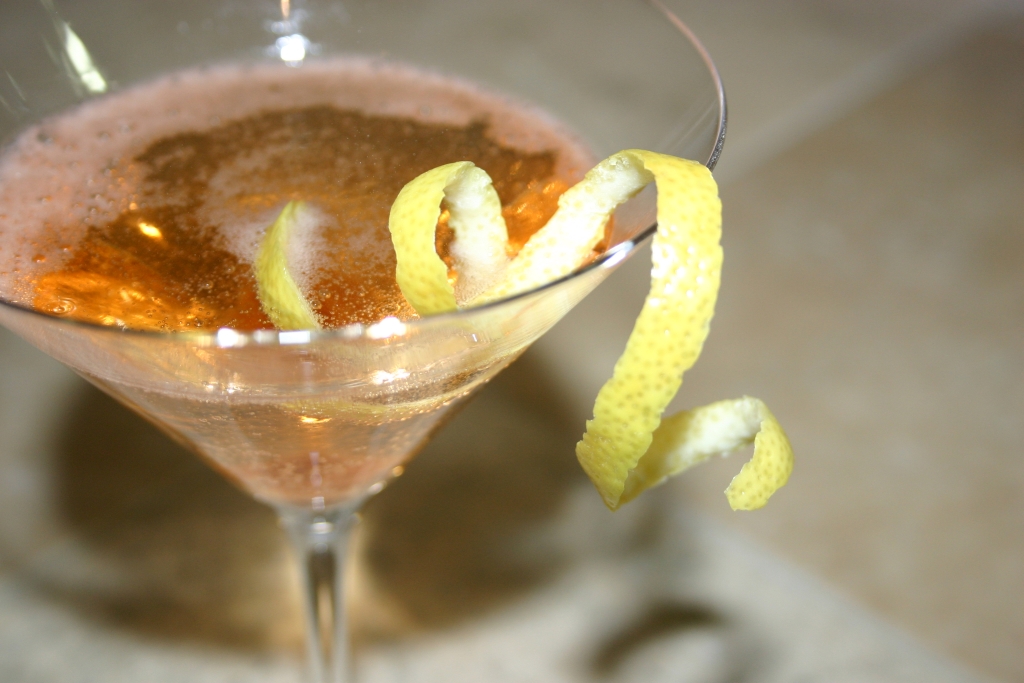Ok, so I really tried to like the Champagne Cocktail and I can’t say that I didn’t, but it certainly wasn’t great. I found that no matter what bitters you use I simply couldn’t get enough of their flavor to shine through to make it worth using decent Champagne. I also changed up the method to see if that would help. I found little to no difference between Gary Regan’s method (bitters soaked sugar cube then champagne) and Robert Hess’ method (champagne then bitters soaked sugar cube). Although if I have to choose I’d say fill the glass with champagne first then drop in the cube. This way the cocktail foams much less and therefore you lose less of the evervescence.
The picture above illustrates one issue that I found with the cocktail. No matter which method you use after a short time (45-60 seconds) you’ll find that you have a layer of white sugar at the very bottom with a layer of bitters syrup immediately on top. As a result you end up with very little of the bitters combining with the cocktail and, as I mentioned above, little of the bitters’ flavors come through. I did find a solution to this issue though. Champagne is generally served in flutes these days, but there is another glass that is traditional, the Champagne saucer or coupe. These glasses are basically a shallow bowl on a stem. I don’t have any Champagne coupes in my glassware collection right now, although I’m certainly going to have to look for some, so I tried serving the cocktail in a cocktail glass.
This actually helped bring the flavor of the bitters out a bit more in the finished product. My somewhat educated guess as to why this is the case is that the champagne circulates more in a wider, more open glass. This in turn better circulates the bitters and sugar and leads to better mixing over all. Although this method was definitely a vast improvement it was still very lacking. So, I next tried a method inspired by Jerry Thomas’ original recipe.
In his recipe Jerry calls for shaking the Champagne, bitters and sugar with ice before serving. Although this would most certainly cause your shaker to explode if you used a full glass of wine it would also mix the bitters and sugar very very well. So I came up with a hybrid method. In your shaker combine an ounce of Champagne (give or take), a teaspoon of simple syrup and three dashes of Angostura bitters. Shake for a bit and add to your cocktail glass. Be careful when opening the shaker, even with this small amount of Champagne mine popped open quite violently. Top your shaken mixture with Champagne to fill you glass.
This method definitely integrates the bitters and sugar much better. What I found was a bit surprising though, the cocktail was still not that great. For you analytical types on a scale of one to meh I’d rate it about a 7.3. So, what’s the solution you ask? I think it’s quite simple. If you have some crappy Champagne leftover by all means mix up a Champagne cocktail, you won’t be displeased, you just won’t be wowed. And use a cocktail glass to get better bitters and sugar mixing. On the other hand, if you have some mid-grade to excellent Champagne left over do yourself a favor and just drink the bubbly as-is. It’s wonderful stuff and generally doesn’t need to be fooled around with.



Comments
2 responses to “Champagne Cocktail – Ummm… Yeah”
[…] the Champagne Cocktail I tried to like the Seelbach. In fact, I’m finishing my last one as I type this. While I […]
[…] The book starts, as it should, with the classics. Some I’ve featured already (eg The Champagne Cocktail and the French 75) and some I have not (look for the Bellini and the Kir Royale later this week). […]